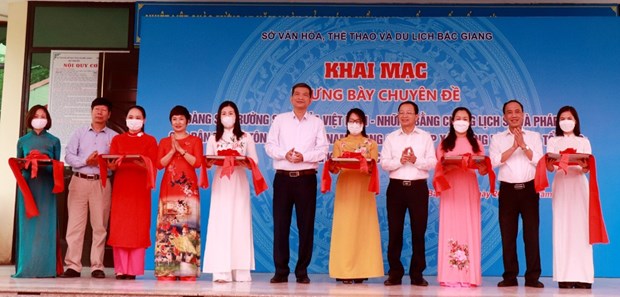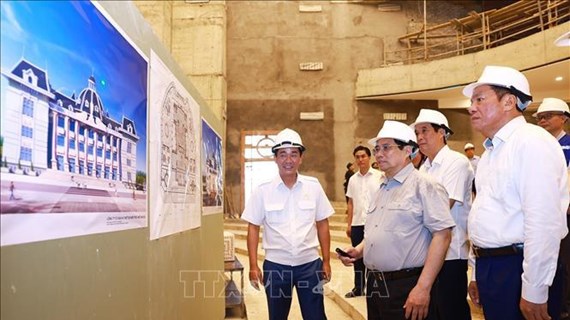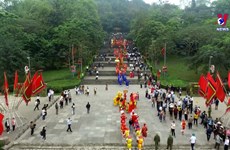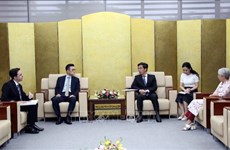Bac Giang locals get deep insight into national sovereignty over islands through exhibition
 At the exhibition's opening ceremony (Photo: baobacgiang.com.vn)
At the exhibition's opening ceremony (Photo: baobacgiang.com.vn)Bac Giang (VNA) –
Locals people in the northern province of Bac Giang have got an in-depth insight into the
national sovereignty over seas and islands as well as the tradition of ethnic
minority groups across Vietnam through photos and documents featuring Vietnam’s
Hoang Sa (Paracel) and Truong Sa (Spratly) archipelagoes and ethnic groups of
Vietnam.
The exhibition, held
recently at the provincial museum, also highlighted the contributions of ethnic
groups and religions to the national construction and defence.
On show are 80 images and
42 exhibits themed “Hoang Sa, Truong Sa belong to Vietnam: historical and legal
evidence” presented by the Ministry of Information and Communications, together
with 180 photos featuring ethnic and religious groups that the Ministry of
Information and Communications presented to the provincial museum in 2020, and
mementos of Bac Giang’s soldiers and civilians during wartime.
They affirm Vietnam’s
sovereignty over the two archipelagos and highlight history and cultural
identity of ethnic groups and Bac Giang province in particular, as well as
contributions of the groups and religions in national construction and
protection.
Deputy Director of the
provincial Department of Culture, Sports and Tourism Nguyen Sy Cam said the
event is hoped to enhance patriotism among youths.
Nguyen Phuong Anh, a student
from Ngo Sy Lien Secondary School in Bac Giang city said that this is the first
time she has joined an exhibition showcasing images and items featuring Hoang
Sa and Truong Sa archipelagos as well as ethnic groups in Vietnam. The
exhibition gave her better understanding on the national sovereignty over seas
and islands as well as the traditional practices of Vietnamese ethnic groups.
Many historical documents
as well as ancient Vietnamese and foreign maps have proved that Vietnam was the
first country to have established sovereignty over the Hoang Sa and Truong Sa archipelagos
when they were unclaimed territories.
Under the reign of King Gia Long (1802-1820) Vietnam’s sovereignty over the Hoang Sa archipelago
was further strengthened.
 At the exhibition (Photo: VNA)
At the exhibition (Photo: VNA)In 1805, the King ordered
a land survey from the south to the north of the country and requested the
making of administrative documents on land areas, which was completed in 1836.
The King also
re-established the Hoang Sa flotilla and its affiliated unit, the Bac Hai
flotilla, with the aim of managing, protecting, and exploiting Hoang Sa and
Truong Sa.
The activities of the
Hoang Sa flotilla are recorded in the two main national history books of
Vietnam under the Nguyen Dynasty: Dai Nam Thuc Luc tien bien, published in
1844, and Dai Nam Thuc Luc chinh bien, in 1848.
Other historical evidence
on the management and exploitation of the two archipelagos is systematically
recorded in detail in many other ancient Vietnamese bibliographies, and
especially in official documents from dynasties stored at the National Archives
Center No 1.
Recently-collected
evidence of the establishment and enforcement of State sovereignty over the
Hoang Sa archipelago is the birth certificate of Mai Kim Quy that states that
Quy was born at 3pm on December 7, 1939, on Hoang Sa Island (Pattle Island), in
the Hoang Sa archipelago. The certificate was signed and sealed by a
representative of the French administrative unit based on Hoang Sa on June 28,
1940.
Historical evidence of
Vietnam’s long-standing sovereignty over the two archipelagos is also recorded
in many documents from foreign authors.
The above-mentioned
evidence shows that Vietnam was the first country to have established and
exercised sovereignty over the two archipelagos in a peaceful, open, and
continuous manner and since at least the 17th century. This is also in
accordance with international law and is clearly and widely recognised by the
international community./.













